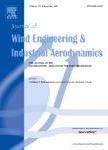版权所有:内蒙古大学图书馆 技术提供:维普资讯• 智图
内蒙古自治区呼和浩特市赛罕区大学西街235号 邮编: 010021

作者机构:SASTRA Deemed Univ Sch Mech Engn Turbulence & Flow Control Lab Thanjavur 613401 Tamil Nadu India Tongji Univ State Key Lab Disaster Reduct Civil Engn Shanghai 200092 Peoples R China
出 版 物:《JOURNAL OF WIND ENGINEERING AND INDUSTRIAL AERODYNAMICS》 (风力工程和工业空气动力学杂志)
年 卷 期:2020年第202卷
页 面:104188-104188页
核心收录:
学科分类:08[工学] 0814[工学-土木工程] 0801[工学-力学(可授工学、理学学位)]
基 金:Science Engineering Research Board (SERB) Department of Science & Technology (DST) Government of India [ECR/2017/001199]
主 题:Turbulence intensity Passive grid Simultaneous pressure distribution Standard deviation Leading-edge protuberance
摘 要:A series of wind tunnel tests were performed to investigate the effect of turbulent inflows on the aerodynamic characteristics of variously modified leading-edge protuberanced (LEP) wing configurations at various turbulence intensities. A self-developed passive grid made of parallel arrays of round bars was placed at different locations of the wind tunnel to generate desired turbulence intensity. The aerodynamic forces acting over the baseline straight leading-edge model and the modified small, medium and high LEP wing configurations were obtained from the surface pressure measurements made over the wing at different turbulence intensities using MPS4264 Scanivalve simultaneous pressure scanner corresponding to a sampling frequency of 700Hz. All the test models were tested for a wide range of angles of attack ranging between −45° ≤ α ≤ 45° at turbulence intensities varying between 0.51% ≤ TI ≤ 4.92%. Results reveal that the time-averaged mean coefficient of lift (CL) increases with the increase in the turbulence intensity associated with smooth stall characteristics rendering the modified LEP test models advantageous. Furthermore, based on the surface pressure coefficients the underlying dynamics behind the stall delay tendency were discussed. Additionally, attempts were made to statistically quantify the aerodynamic forces using standard deviation at both the pre-stall and the post-stall angles.